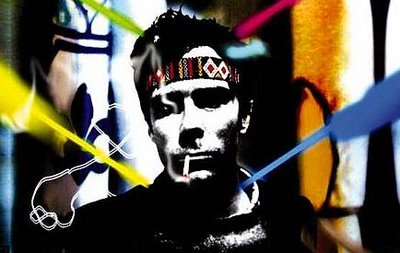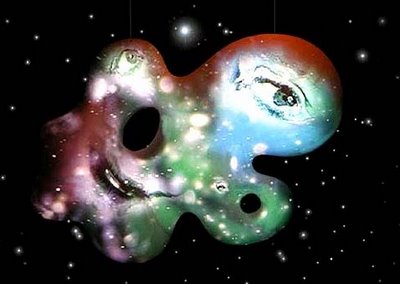When I first arrived in Southern California, I was struck by the free-for-all profusion of creativity, and the wide variety of art and architecture styles. Much more eclectic than in "established" markets like Paris, London or New York. My initial reaction was that of many Euros: rejection. So many kitschy scribbles and pompous christmas puddings, so much unsorted "junk". What was this tacky place?
I realized my own snobbish myopia at a James Turrell talk, when he stated: "The great thing about L.A. is that it's free from taste." It was an epiphany. Yes, there is a lot of junk in L.A., but there is also a lot of extraordinary, breaktrough work, which might not be allowed to exist in more established markets where the notions of "art" and "taste" often border on the doctrinaire.
 The question is: what is art? how can you define it? who is entitled to define it? It's not so clear-cut anymore. "Forget isms -- except eclectism", writes Christopher Knight in a recent article for the L.A.Times. "The days when a succinct response might quickly sum up the art scene are long gone [...] art, wherever it is made, no longer subscribes to a single dominant trend with a few rambunctious alternatives jostling for supremacy."
The question is: what is art? how can you define it? who is entitled to define it? It's not so clear-cut anymore. "Forget isms -- except eclectism", writes Christopher Knight in a recent article for the L.A.Times. "The days when a succinct response might quickly sum up the art scene are long gone [...] art, wherever it is made, no longer subscribes to a single dominant trend with a few rambunctious alternatives jostling for supremacy."
Knight reviews various exhibits in L.A., remarking that "their extreme eclectism is not exclusive to California. It's the norm everywhere today." The rupture point? Pop Art. Knight explains: Knight concludes that we now live in "a post-Pop world, ism-free and with no end in sight. Pop culture used to be synonymous with mass culture, but in the era of 500 cable channels, iPods and the Internet, broadcasting has faltered and been joined by vibrant narrowcasting." Thus what he calls "our robust artistic bounty today."
Knight concludes that we now live in "a post-Pop world, ism-free and with no end in sight. Pop culture used to be synonymous with mass culture, but in the era of 500 cable channels, iPods and the Internet, broadcasting has faltered and been joined by vibrant narrowcasting." Thus what he calls "our robust artistic bounty today."
We have entered an age where everyone is his/her own art critic. Hence the exhilaration of living in Southern California, a place at the forefrront of creativity -- junk and gems.
photos LATimes for Knight's article/works by Jeremy Black & Tony OurslerI realized my own snobbish myopia at a James Turrell talk, when he stated: "The great thing about L.A. is that it's free from taste." It was an epiphany. Yes, there is a lot of junk in L.A., but there is also a lot of extraordinary, breaktrough work, which might not be allowed to exist in more established markets where the notions of "art" and "taste" often border on the doctrinaire.
 The question is: what is art? how can you define it? who is entitled to define it? It's not so clear-cut anymore. "Forget isms -- except eclectism", writes Christopher Knight in a recent article for the L.A.Times. "The days when a succinct response might quickly sum up the art scene are long gone [...] art, wherever it is made, no longer subscribes to a single dominant trend with a few rambunctious alternatives jostling for supremacy."
The question is: what is art? how can you define it? who is entitled to define it? It's not so clear-cut anymore. "Forget isms -- except eclectism", writes Christopher Knight in a recent article for the L.A.Times. "The days when a succinct response might quickly sum up the art scene are long gone [...] art, wherever it is made, no longer subscribes to a single dominant trend with a few rambunctious alternatives jostling for supremacy."Knight reviews various exhibits in L.A., remarking that "their extreme eclectism is not exclusive to California. It's the norm everywhere today." The rupture point? Pop Art. Knight explains:
Twentieth century art was long charted as an almost linear succession of "isms" — from Fauvism in 1905 to Abstract Expressionism in the 1950s — discrete movements that each expressed its own unitary view of things. The monolithic view that had congealed by the 1960s was a belief that the eye held dominion over art. That limited judgment was toppled by Conceptualism, which devalued everything visual in art and instead polished up the stature of ideas.
Looking back from today's art world, though, a slightly different history of eclectic art suggests itself. Conceptual art doesn't mark the decisive break, just the elaboration and consolidation of an idea already in play. Pop art marks the most profound rupture [...] Pop made hash of the rigid hierarchy of high art (painting, sculpture, drawing) and low art (TV, tabloids, photographs). An entrenched legacy of an aristocratic worldview, this hierarchy of high and low was traded in for a more fluid, porous pecking order.
 Knight concludes that we now live in "a post-Pop world, ism-free and with no end in sight. Pop culture used to be synonymous with mass culture, but in the era of 500 cable channels, iPods and the Internet, broadcasting has faltered and been joined by vibrant narrowcasting." Thus what he calls "our robust artistic bounty today."
Knight concludes that we now live in "a post-Pop world, ism-free and with no end in sight. Pop culture used to be synonymous with mass culture, but in the era of 500 cable channels, iPods and the Internet, broadcasting has faltered and been joined by vibrant narrowcasting." Thus what he calls "our robust artistic bounty today."We have entered an age where everyone is his/her own art critic. Hence the exhilaration of living in Southern California, a place at the forefrront of creativity -- junk and gems.

No comments:
Post a Comment